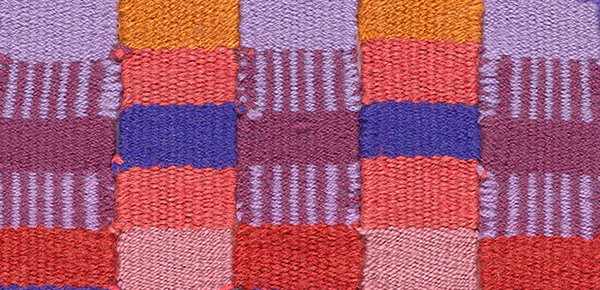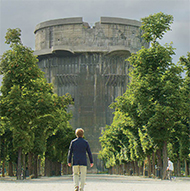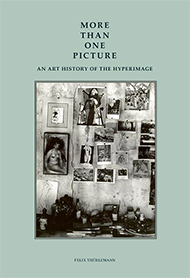Weaving sample for a wall hanging (detail), Immeke Mitscherlich-Schwollmann, ca. 1925. The Getty Research Institute,
850514.
CLOSING THIS MONTH
| |
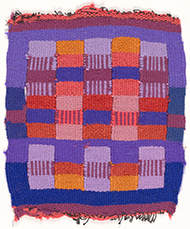 Weaving sample for a wall hanging, Immeke Mitscherlich-Schwollmann, ca. 1925. The Getty Research Institute, 850514.
Weaving sample for a wall hanging, Immeke Mitscherlich-Schwollmann, ca. 1925. The Getty Research Institute, 850514.
|
Bauhaus Beginnings
Through October 13, 2019 | The Getty Center
Masters at the Bauhaus hoped to turn a profit from the sale of objects students had designed and manufactured in the school's workshops. The weaving workshop was the only workshop to fulfill this ambition: Bauhaus textiles were technically and materially innovative and were manufactured in bulk and sold widely. Students were encouraged by early Bauhaus master Helene Börner to draw upon foundational theories of color and form to produce innovative designs like this colorful wall hanging, currently on display as part of the exhibition
Bauhaus Beginnings.
Gallery tours are held Tuesdays and Thursdays at 2:00 p.m. through October 10.
Learn more about Bauhaus Beginnings.
| |
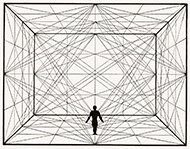 Figur und Raumlineatur (Figure and space delineation), Oskar Schlemmer, 1924. Letterpress on paper. 8 x 10.5 cm. From Oskar Schlemmer, "Mensch und Kunstfigur" in Walter Gropius and Låszló Moholy-Nagy, eds., Die Bühne im Bauhaus, Bauhausbücher 4 (Munich: Albert Langen, 1924) p. 13. The Getty Research Institute, 84-B6773
Figur und Raumlineatur (Figure and space delineation), Oskar Schlemmer, 1924. Letterpress on paper. 8 x 10.5 cm. From Oskar Schlemmer, "Mensch und Kunstfigur" in Walter Gropius and Låszló Moholy-Nagy, eds., Die Bühne im Bauhaus, Bauhausbücher 4 (Munich: Albert Langen, 1924) p. 13. The Getty Research Institute, 84-B6773
|
Bauhaus: Building the New Artist
The Bauhaus ideal of the
gesamtkunstwerk, or the total work of art, required students to engage a holistic education which considered mind, body, and spirit in an effort to unify psychic and material impulses. This philosophy is best illustrated through the ambitious artistic projects forged through a synthesis of the arts—architecture and theater, for example, required orchestration of form, color, material, and movement both spatially and in relation to the human body. This concept and other attitudes toward art and education are explored in the online exhibition
Bauhaus: Building the New Artist.
Enter the exhibition.
EVENT
The Burning Child
Film Screening | October 15, 2019 | 6:30 p.m. | The Getty Center
The Burning Child (2019) is a journey into the heart of the city and a study of the Viennese approach to interior design, built architecture, and those who were inspired by it such as Sigmund Freud, Gustav Klimt, and Ludwig Wittgenstein. Through interviews and archival footage, the film explores a rich history as the filmmaker attempts to solve the riddle of his grandparents' disappearance during the Holocaust. After the screening, the film's creator, Joseph Koerner, hosts a Q&A with the audience.
Reserve a free ticket.
| |
 #4, Sylvia Snowden, 2015. Courtesy Sylvia Snowden (left). Going to NYC, Jae Jarrell, 1994. Courtesy Jae Jarrell (right)
#4, Sylvia Snowden, 2015. Courtesy Sylvia Snowden (left). Going to NYC, Jae Jarrell, 1994. Courtesy Jae Jarrell (right)
|
The Creative Impulse: Jae Jarrell and Sylvia Snowden in Conversation
Conversation | October 24, 2019 | 7:00 p.m. | The Getty Center
Artists Jae Jarrell and Sylvia Snowden come together to discuss art making and the creative impulse along with the history of African American art and its impact on their own art practices. The conversation will be moderated by Bridget R. Cooks, associate professor of African American studies and art history at the University of California, Irvine. This program is associated with the GRI's African American Art History Initiative.
Reserve a free ticket.
Learn more about the African American Art History Initiative.
PUBLICATION
More than One Picture: An Art History of the Hyperimage
Written by Felix Thürlemann
Through case studies of collectors and curators, art historians, and artists, Thürlemann develops a theory of artworks and their photographic reproductions arranged as calculated ensembles that have their own importance. Thuürlemann proposes a theory of hyperimages, explores the semiotic nature of plural image use, and discusses the arrangement and interpretation of pictures to illuminate the phenomenon of Western image culture from the beginning of the 17th century until today.
Reserve this title.
NEW FOR RESEARCHERS
| |
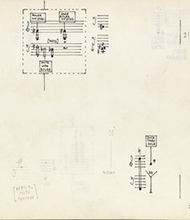 Second realization of John Cage's "Concert for Piano and Orchestra: Solo for Piano" (detail), David Tudor papers, 1800-1998. Getty Research Institute, 980039
Second realization of John Cage's "Concert for Piano and Orchestra: Solo for Piano" (detail), David Tudor papers, 1800-1998. Getty Research Institute, 980039
|
The David Tudor Papers
Finding Aid
Newly identified scores have now been added to the finding aid for the papers of avant-garde pianist and electronic music composer David Tudor. The archive comprehensively documents his participation in postwar experimental music. Discovered within the archive were Tudor's realization for Morton Feldman's
Intersection No. 2 and Feldman's original score as well as Tudor's realization for Earle Brown's
Four Systems.
Browse the finding aid.
CONNECT WITH US
Follow us, learn about what we do, and tell us about your visit!
 Weaving sample for a wall hanging, Immeke Mitscherlich-Schwollmann, ca. 1925. The Getty Research Institute, 850514.
Weaving sample for a wall hanging, Immeke Mitscherlich-Schwollmann, ca. 1925. The Getty Research Institute, 850514.
 Figur und Raumlineatur (Figure and space delineation), Oskar Schlemmer, 1924. Letterpress on paper. 8 x 10.5 cm. From Oskar Schlemmer, "Mensch und Kunstfigur" in Walter Gropius and Låszló Moholy-Nagy, eds., Die Bühne im Bauhaus, Bauhausbücher 4 (Munich: Albert Langen, 1924) p. 13. The Getty Research Institute, 84-B6773
Figur und Raumlineatur (Figure and space delineation), Oskar Schlemmer, 1924. Letterpress on paper. 8 x 10.5 cm. From Oskar Schlemmer, "Mensch und Kunstfigur" in Walter Gropius and Låszló Moholy-Nagy, eds., Die Bühne im Bauhaus, Bauhausbücher 4 (Munich: Albert Langen, 1924) p. 13. The Getty Research Institute, 84-B6773


